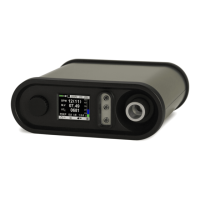Ventway Sparrow User Manual
Page 28 of 144
Solenoid valves exhaust – scavenging of gas residue from the solenoids, passed to inlet to prevent oxygen buildup inside
the enclosure.
Manifold assembly – encapsulates all electromechanical control elements, membranes, valves and air tubes in one
compact element. This design eliminates the use of air tubes and pneumatic connectors.
Inspiratory control valve – controls the main inspiratory valve.
Exhalation control valve – controls the patient exhalation valve membrane, located in the patient circuit transducer.
Exhalation control tube – transferring pressure from the exhalation control valve to the exhalation valve membrane. It is
a part of the patient circuit.
Inspiratory tube – a 15 mm or 22 mm tube, connecting the ventilator and the patient. Used for delivering the gas mixture
to the patient’s airways.
PEEP valve – Spring activated membrane (same membrane used for exhalation control). Adjustable by rotating a knob.
Anti asphyxia valve – designed to allow the patient to inhale through an emergency intake port separated from the regular
inlet, in case of failure of the ventilator.
Blower – A radial blower, referred to sometimes as “turbine”. Intended to generate pressure and flow of gas mixture either
from the ambient air or from a mixture of air and oxygen.
Bleeding conduit and continuous bleed valve – orifice used for passing small amounts of flow, compensating for any leaks
that may occur in the patient circuit, and removing any CO2 from the patient circuit.
Main inspiratory valve – normally open valve. Main valve designed to allow passage of gas from the blower to the patient.
Flow and pressure sensor – a part of the patient circuit. A constant orifice sensor used for acquiring the flow and pressure
in the patient’s airways and passing them to pressure sensors located in the ventilator’s electronic unit.

